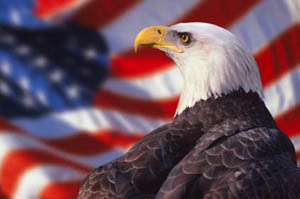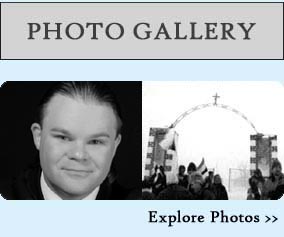EAGLE FEATHER LAW
RESOURCE GUIDE
Welcome to the Eagle Feather Law Resource Guide.
Here you will find a number of resources to learn more Title 50 Part 22 of the Code of Federal Regulations, commonly called the "eagle feather law."

Listed below are links to numerous resources ranging from published articles to court cases and petitions connected to the law and the eagle feather law controversy. You will also find instructions about how to voice your opinion about the eagle law, such as information about how to contact your elected leaders and how to write letters to the editor. Also included are links to resources on the identification of eagle feather and parts.
Those with legal questions regarding court cases, their specific circumstances, and those seeking legal advice, services, or referrals should contact an attorney within their state for assistance. Individuals looking to file a complaint about civil rights violations are encouraged to contact local law enforcement agencies and the Office for Civil Rights, Human Rights Watch, Native American Rights Fund, and the American Civil Liberties Union.
This guide will be shaped and expanded to suit people's needs and interests. You are invited particiapte in this process by sharing your thoughts and opinions with the guide's author, Dr. DaShanne Stokes, on Twitter @DaShanneStokes and Facebook. You can also join the conversation about the eagle feather law on Twitter using the hashtag #EagleFeatherLaw, and can share the link to this guide over social media using the shortened link bit.ly/1fy55cJ.
Links to external sites are necessarily subject to unannounced changes. Please report broken links here.
Here is a listing of the resources you'll find on this page:
- Articles About the Eagle Feather Law
- The Eagle Feather Law in the Media
- Eagle Feather and Eagle Feather Law Related Videos and Clips
- The #LetTheFeathersFly Hashtag Movement
- Articles and Videos About Robert Soto
- List of Federal and State Recognized Tribes
- How to Contact Your Elected Leaders About the Eagle Feather Law
- How to Call in to Talk Radio About the Eagle Feather Law
- How to Write a Letter to the Editor About the Eagle Feather Law
- Eagle Feather Identification Guides
- Eagle Feather Law Court Cases
- Reports, Laws, and Legal Documents Related to the Eagle Feather Law
Timeline of Important Events Surrounding the Eagle Feather Law
1887
The U.S. government passes the Dawes Act, creating the concept and practice of "tribal enrollment" to assist with tribal assimilation and the seizure of tribal lands. The Dawes Rolls go on to become a major criterion for tribal enrollment and CDIB (Certificate of Degree of Indian Blood) numbers used to determine tribal membership and eligibility for eagle permits.
(Source: Stokes, DaShanne. 2007. "Time for New Eagle Feather Law." Indian Country Today, February 16. http://indiancountrytodaymedianetwork.com/2007/02/16/stokes-time-new-eagle-feather-law-90348)
1940s - 1960s
The "termination era." During the termination era, over 100 tribes lose their federal recognition status. Had termination remained in effect, members of these tribes would not be federally recognized today and would not be allowed to obtain or possess eagle feathers and parts under the current policy.
1963
The Secretary of the Interior first establishes the eagle feather permit program under the "Indian tribes" exception. As originally written, regulations allowed for permits to be issued "to those individual Indians who are authentic, bona fide practitioners of such religion."
(Source: Saenz v. Interior 2001: D.C. No. 99-21-M)
1974
The Secretary of the Interior changes the eagle law regulations, requiring that applicants "attach a certification from the Bureau of Indian affairs that the applicant is an Indian."
(Source: Saenz v. Interior 2001: D.C. No. 99-21-M)
1978
The American Indian Religious Freedom Act is passed.
1981
18 years after regulations first created, requirement is added that permit applicants must be members of federally recognized tribes.
(Source: Saenz v. Interior 2001: D.C. No. 99-21-M)
1994
In Coyote v. U.S. Fish and Wildlife Service (1994), the court finds that requiring eagle permit applicants be members of federally recognized tribes "is both contrary to the plain reading of that regulation and arbitrary and capricious."
1999
Regulatory language is changed to clearly reflect that permit applicants must be members of federally recognized tribes. (Source: Saenz v. Interior 2001: D.C. No. 99-21-M)
2001
In Saenz v. Department of Interior (2001), the court also found that ''whether or not a particular tribe has been formally recognized for political purposes bears no relationship whatsoever to whether or not an individual practitioner is of Indian heritage by birth, sincerely holds and practices traditional Indian religious beliefs, is dependent on eagle feathers for the expression of those beliefs, and is substantially burdened when prohibited from possessing eagle parts.''
2002
In Hardman vs. U.S. (2002), the court finds that there was "insufficient evidence presented by the government to show that expanding the permit system to non-Native American adherents of Native American religions would threaten the eagle population or destroy the government's trust obligations to Native American tribes... with no effect on eagles."
2003
Chief Arvol Looking Horse publishes two articles in Indian Country Today on the protection of ceremonies. In his articles, Looking Horse states that non-Natives would no longer be allowed into sacred ceremonies run by Looking Horse and his supporters. Looking Horse advocates for eagle feathers to be limited to enrolled tribal members.
(Sources: Looking Horse, Arvol. 2003. "Looking Horse Proclamation on the Protection of Ceremonies." Indian Country Today. March 13; Looking Horse, Arvol. 2003. "Further thoughts on the protection of ceremonies." Indian Country Today. July 7.)
Tom Cook and supporters of the Sun Dance in the Black Hills expresses concerns over Looking Horse's articles. Cook's article calls on people to reflect on the meaning of "mitakuye oyasin" and says that membes of the Sun Dance in the Black Hills "can not endorse the ethnic limitations placed on the use of the Sacred Pipe" argued by Looking Horse as they can not endorse a "racist approach."
(Source: Cook, Tom K. 2003. "Mitakuye Oyasin: A Response to the Looking Horse Proclamation." Indian Country Today, April 25.)
2005
DaShanne Stokes founds Religious Freedom with Raptors, a political interest advocacy group dedicated to reforming the eagle feather law to protect individual and tribal rights to religious freedom. RFR launches petitions, application drives, letter campaigns, and more. RFR authors a bill to protect the religious freedom of members of state recognized tribes to possess eagle feathers.
2006
In U.S. v. Friday (2006), the court finds that "the present application of the permitting process is not the least restrictive means of doing so. [I]t is the biased and protracted nature of the process that cannot be condoned as an acceptable implementation of the BGEPA. To show deference to the agency's implementation of the permitting process is to honor the hypocrisy of the process. Although the Government professes respect and accommodation of the religious practices of Native Americans, its actions show callous indifference to such practices. It is clear to this Court that the Government has no intention of accommodating the religious beliefs of Native Americans expect on its own terms and in its own good time."
2007
RFR helps to mobilize opposition to California State Senate bill AB1729, which would have forbade the acquisition of eagle feathers and parts on non-tribal lands and would have facilitated the arrest and harassment of tribal members not carrying tribal identification cards during ceremonies. The bill, had it passed with its original language, would have affected some 433,000 Native American people, comprising 14% of the U.S. indigenous population.
2008
RFR authors the "Religious Freedom for State Recognized Tribes Act." The bill, if passed, would have expanded the eagle permit system to include state-recognized tribes, thereby helping to protect their cultural survival and constitutional rights to religious freedom. The bill would have also maintain the system's current protections of eagle populations and trust responsibilities to federally recognized tribes.
(Source: Stokes, DaShanne. 2008. "Eagle Feathers and the Imperialist Conquest of State Recognized Tribes." Indian Country Today, August 12. http://indiancountrytodaymedianetwork.com/2008/08/12/stokes-eagle-feathers-and-imperialist-conquest-state-recognized-tribes-79246)
2008
An article by DaShanne Stokes reveals that only 1.1 percent of the nearly 2,000,000 members of federally recognized tribes have eagle permits.
(Source: Stokes, DaShanne. 2008. "Eagle Feathers and the Imperialist Conquest of State Recognized Tribes." Indian Country Today, August 12. http://indiancountrytodaymedianetwork.com/2008/08/12/stokes-eagle-feathers-and-imperialist-conquest-state-recognized-tribes-79246)
2012
October 12 Memo Issued. The memo changes regulations so that members of federally recognized tribes may possess eagle feathers and parts without a permit. This effectively transformed tribal enrollment and identification cards into permits themselves. (Source: U.S. Department of Justice. Memo. http://www.justice.gov/sites/default/files/ag/legacy/2012/10/22/ef-policy.pdf)
2014
The 5th Circuit Court of Appeals finds that the U.S. government failed to prove that denying Robert Soto, a member of the state-recognized Lipan Apache tribe, eagle feathers needed for his ministry advanced a compelling government interest. Soto had been arrested for having eagle feathers at a pow wow in Texas in 2006. The Court also found that the government failed to prove that giving members of state-recognized tribes access to eagle feathers would in any way harm its relationship with federally-recognized tribes. (Source: Stokes, DaShanne. 2014. "Eagle Feathers and State Recognized Tribes." Indian Country Today, September 2. http://indiancountrytodaymedianetwork.com/2014/09/02/eagle-feather-law-and-state-recognized-tribes)
2015
After almost nine years, eagle feathers seized from Robert Soto are returned to him by the U.S. Fish and Wildlife Service. (Source: Indian Country Today. 2015. "U.S. Returns Eagle Feathers to Lipan Apache Religious Leader After Court Fight." Indian Country Today, March 10. http://indiancountrytodaymedianetwork.com/2015/03/10/us-returns-eagle-feathers-lipan-apache-religious-leader-after-court-fight-159543)
Articles About the Eagle Feather Law
Associated Press. 2009. "Judge Overturns Restrictions on Eagle Feathers." The Denver Post. February 18.
Becket Fund. 2015. "Government Returns Confiscated Eagle Feathers to Tribal Leader, But Still Enforces Arbitrary Law."Becket Fund, March 10.
Berry, Carol. 2009. "Native Law Group Tackles Eagle Feather Controversy." Indian Country Today. May 11, 2009.
Cook, Tom K. 2003. "Mitakuye Oyasin: A Response to the Looking Horse Proclamation." Indian Country Today, April 25.
DeMeo, Antonia M. 1995. "Access to Eagles and Eagle Parts: Environmental Protection v. Native American Free Exercise of Religion." Hastings Constitutional Law Quarterly 22 (3): 771-813.
Draper, Electa. 2011. "Court Overturns Case That Allowed Non-Indians to Possess Eagle Feathers." The Denver Post. March 29.
Geller, Hallie. 2013. "Feather Dust-up: Why the DOJ Feather Policy Must Change." Indian Country Today Media Network, July 13.
Hotakainen, Rob. 2013. "Some Native Americans defy U.S. law on eagle feathers." The Washington Post, February 22.
Laird, Lorelei. 2015. "American Indians challenging eagle feather rules get a boost from Hobby Lobby ruling." ABA Journal, January 1.
Looking Horse, Arvol. 2003. "Looking Horse Proclamation on the Protection of Ceremonies." Indian Country Today. March 13.
Looking Horse, Arvol. 2003. "Further thoughts on the protection of ceremonies." Indian Country Today. July 7.
Martinez, Michale. 2015. "Religious freedom laws: How some controversial cases panned out."CNN.
Ryan, Daniel. 2012. "Feds to Broaden Native Americans' Right to Possess Eagle Feathers." Los Angeles Times, October 12.
Stokes, DaShanne. 2007. "Time for New Eagle Feather law."Indian Country Today, February 21, 2007, pp. A2.
Stokes, DaShanne. 2008. "Eagle Feathers and the Imperial Conquest of State Recognized Tribes." Indian Country Today. August 13, 2008, pp. 5.
Stokes, DaShanne. 2014. "The Eagle Feather Law and State Recognized Tribes." Indian Country Today
Stokes, DaShanne. 2015. "A Life in America Without Religious Freedom." The Huffington Post. September 24, 2015.
The Eagle Feather Law in the Media
"Interview with DaShanne Stokes."
June 4, 2015.
This Show Is So Gay
"Fight Over Eagle Feathers."
Wednesday, February 18, 2015.
Native America Calling
"The Eagle Feather Law: How Religious Freedom in America is Restricted for Native Americans."
Thursday, March 1, 2007.
First Voices Indigenous Radio, WBAI 99.5 FM.
"The Sanctity of Eagles."
Tuesday, December 19, 2006.
Native America Calling
The #LetTheFeathersFly Hashtag Movement
North Dakota Natives Fight for Right to Wear Eagle Feathers at Graduation
North Dakota Natives Win Eagle Feather Fight for Graduating Students
Eagle Feather and Eagle Feather Law Related Videos and Clips
"Government infiltrates Native pow wow, takes eagle feathers."
"Government returns confiscated eagle feathers."
How do I take care of my eagle feather?
Angelique EagleWoman: The Importance of Eagle Feathers
Chief Oren Lyons: Importance of Feathers & the Next Generation
Feather Wisdom: Oglala Lakota Sun Dance Singer Oyate Hoyekyapi
Native American Talks About Importance of Eagle Feathers
Native Eagle Feather Teachings By Adrian LaChance
Articles and Videos About Robert Soto
Religious Freedom Laws: How Some Controversial Cases Panned Out
U.S. Returns Eagle Feathers to Lipan Apache Religious Leader After Court Fight
Texas Tribe Continues Lawsuit Against Feds While Settling in McAllen
List of Federal and State Recognized Tribes
NCSL: Federal and State Recognized Tribes
How to Contact Your Elected Leaders About the Eagle Feather Law
How to Call in to Talk Radio About the Eagle Feather Law
How to be an Effective Radio Call In Guest
How to Write a Letter to the Editor About the Eagle Feather Law
How to Write Letters to the Editor
Eagle Feather Identification
The Feather Atlas (Flight feathers of North American Birds)
Identification of Eagle Feathers and Feet (pdf)
Identification of eagle feather and laws governing possessing American Bald Eagle parts
Eagle Feather Law Court Cases
McAllen Grace Brethren Church v. Salazar (2014)
Burwell v. Hobby Lobby Stores (2013)
U.S. v. Wilgus (2011)
U.S. v. Wilgus (2009)
U.S. v. Vasquez-Ramos (2008)
U.S. v. Winddancer (2006)
U.S. v. Friday (2006)
U.S. v. Antoine (2003)
U.S. v. Kornwolf (2002)
U.S. v. Hardman Rehearing En Banc U.S. Dist. Courts NM & UT (2002)
U.S. v. Hardman (2002)
U.S. v. Hardman (2002) (On Rehearing En Banc)
U.S. v. Wilgus (2001)
U.S. v. Hardman Appeal From U.S. District Court Utah (2001)
U.S. v. Wilgus Appeal From U.S. District Court Utah (2001)
Saenz v. Department Of Interior (2001)
U.S. v. Hardman & Wilgus (2001)
Gibson v. Babbit (2000)
U.S. v. Sandia (1999)
United States v. Gonzales (1997)
Horen v. Commonwealth (1997)
U.S. v. Hugs (1997)
U.S. v. Lundquist (1996)
U.S. v. Jim (1995)
Coyote v. U.S. Fish and Wildlife Service (1994)
Rupert v. Director, United States Fish and Wildlife Service (1992)
U.S. v. Thirty-Eight Golden Eagles (1986)
U.S. v. Dion (1986)
U.S. v. Abeyta (1986)
U.S. v. FrybergU.S. v. Fryberg (1980)
Andrus v. Allard (1979)
U.S. v. Top Sky (1976)
U.S. v. White (1974)
Reports, Laws, and Legal Documents Related to the Eagle Feather Law
50 CFR 22
American Indian Religious Freedom Act (1978)
Avalon Project at Yale Law School
Bald and Golden Eagle Protection Act
Civil Rights Act (1964)
The Dawes Act (1887)
The Declaration of Independence
DOJ October 12 Memo On Possession or Use of the Feathers or Other Parts of Federally Protected Birds for
Tribal Cultural and Religious Purposes (2012)
Eagle Parts for Native American Religious Purposes Permit Application and Shipping Request
Early Recognized Treaties with American Indian Nations
Endangered Species Act (1973)
The First Amendment (1791)
Handbook of Federal Indian Law(Cohen, 1941)
Indian Affairs: Laws and Treaties
Indian Civil Rights Act (1968)
Indian Reorganization Act (1934)
The Lacey Act (1900)
Migratory Bird and Eagle Permits
Migratory Bird Treaty Act (1918)
The Ninth Amendment (1791)
The Pluralism Project, Research Report: Eagle Feathers and U.S. Permit Process (2007)
Policy Concerning Eagle Feathers Native American Religious (1994)
Religious Ceremonial Collection of Golden Eaglets from Wupatki National Monument (2001)
Religious Freedom Restoration Act (1993)
U.S. Fish & Wildlife Resource Laws
Clinton, William J. Executive Memorandum: "Policy Concerning Distribution of Eagle Feathers for Native American Religious." 59 F.R. 22953 (1994).
Eagle Permits. 50 C.F.R. 22.
U.S. Fish and Wildlife Service. 2001. "Native American Activities: Migratory Bird Feathers."
U.S. Fish and Wildlife Service. "Eagle Parts for Native American Religious Purposes Permit Application and Shipping Request."
U.S. Fish and Wildlife Service. 1994. "The Native American Policy of the U.S. Fish and Wildlife Service." Washington, D.C.



